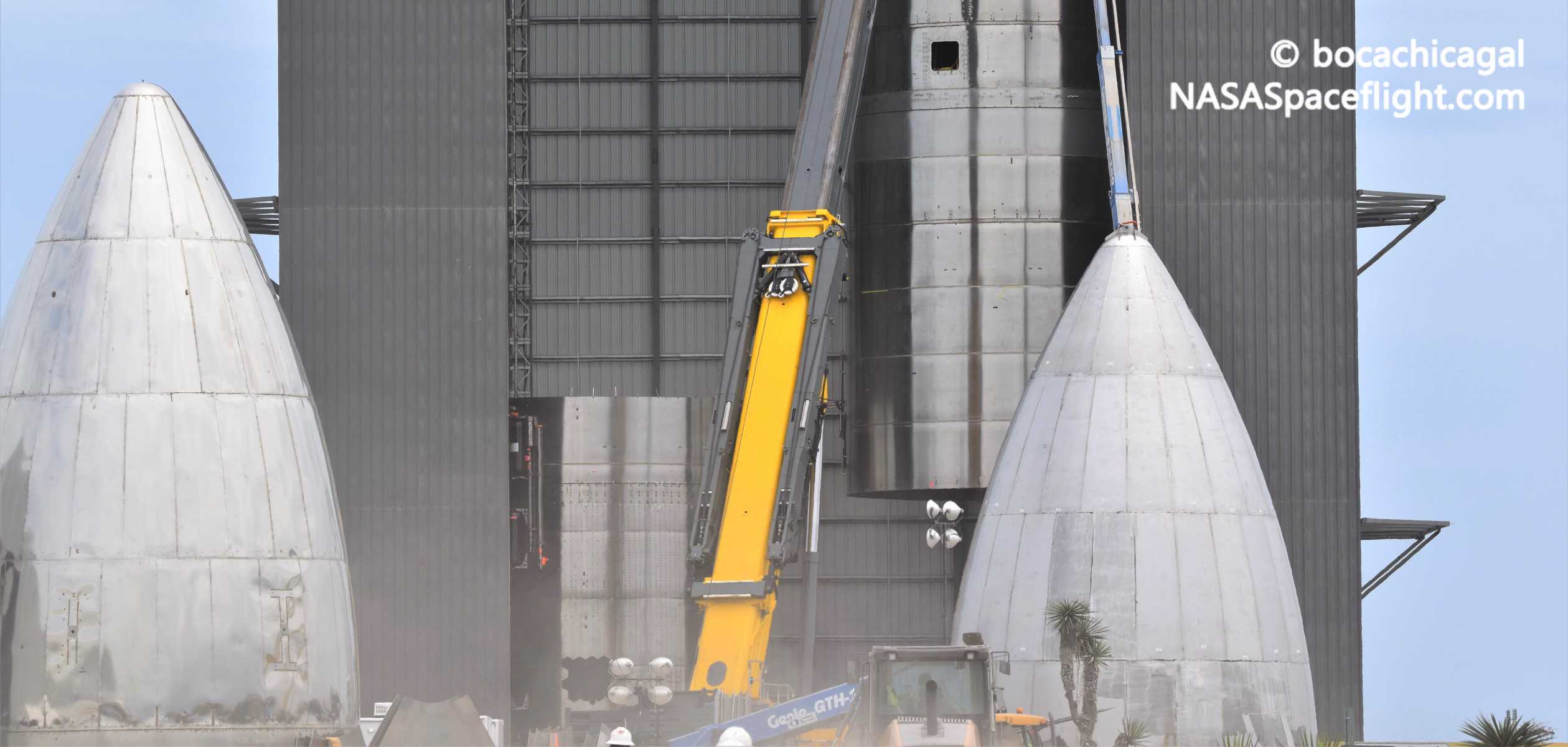
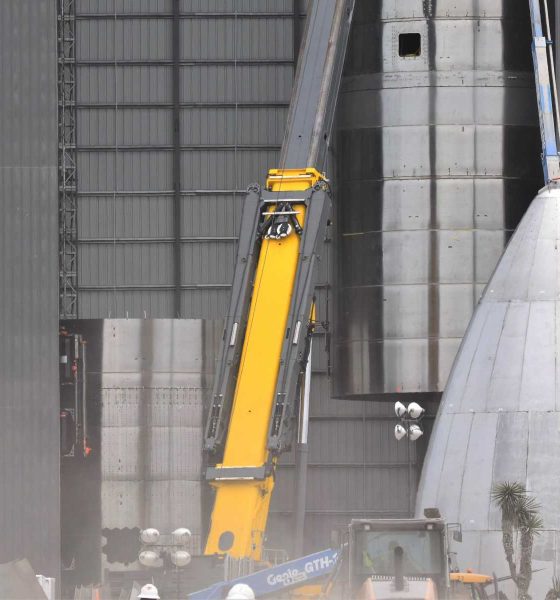
News
SpaceX is about to have a fleet of Starship rockets
SpaceX has finished the last major stacking event for the business half of its fifth full-scale Starship prototype, meaning that the company may be a week or less from having a fleet of Starships for the first time ever.
As of now, Starship serial number 5 (SN5) is on track to be completed in under a month, continuing a trend that SpaceX has managed over the entirety of 2020. Beginning in mid-January, SpaceX has completed several nosecone pathfinders, three test tanks, and three full-scale Starship prototypes – soon to be four once SN5 is finished. Once it is, however, SpaceX will be entering a new era of operations – fleet operations.
Up to this point, every full-scale Starship prototype and test tank SpaceX has built – excluding the tank SN2 was turned into in March – has been quickly destroyed over the course of one or two tests. For better or for worse, this has meant that SpaceX’s test and launch pad has always been more or less self-clearing, making way for the next prototype to roll out and begin testing after the scraps of its predecessor were removed. This time around, barring Starship SN4’s imminent demise, SpaceX will now have to deal with multiple completed Starship prototypes at the same time – a tiny taste of things to come.
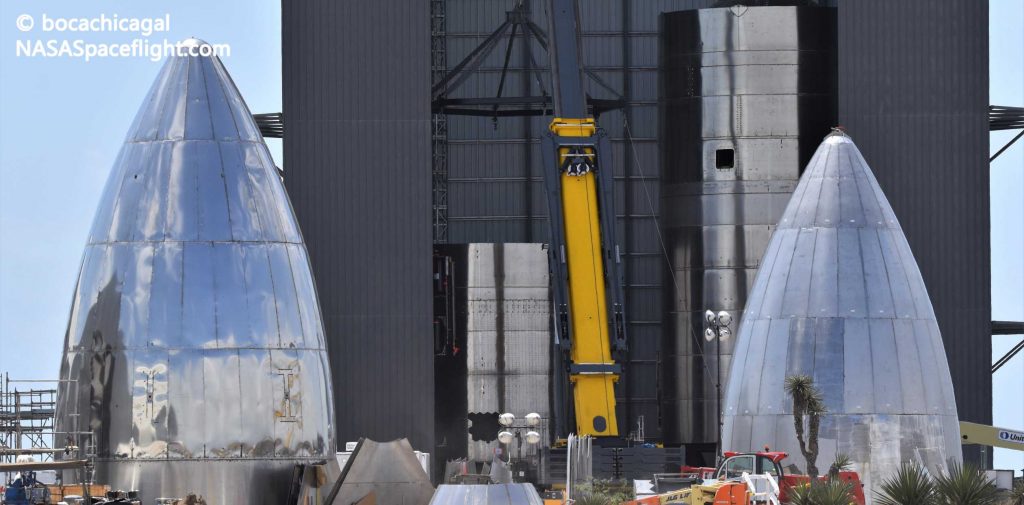
For unknown reasons, SpaceX decided to swap out Starship SN4’s lone Raptor engine (likely SN18) after multiple wet dress rehearsals, partial engine tests, and two static fire tests – at least one of which was confirmed a success by CEO Elon Musk. Most recently, SpaceX removed Raptor SN18 to perform a more ambitious cryogenic pressure test, pushing Starship SN4’s propellant tanks all the way to 7.5 bar (~110 psi) at the same time as hydraulic rams simulated the thrust of three Raptor engines at the rocket’s base.
Instead of reinstalling Raptor SN18, SpaceX transported Raptor SN20 to the launch pad and installed it on Starship SN4 on May 10th, less than 24 hours after the prototype passed an orbital-class pressure test.
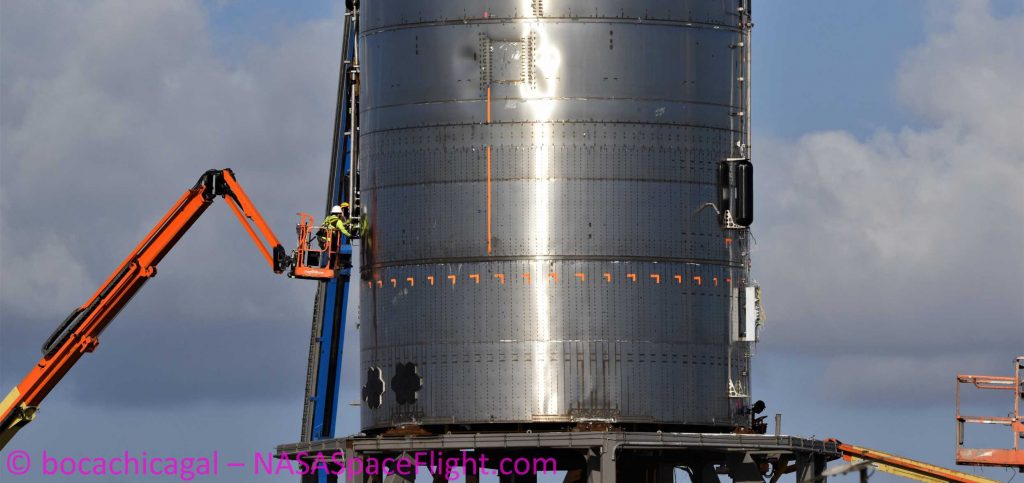
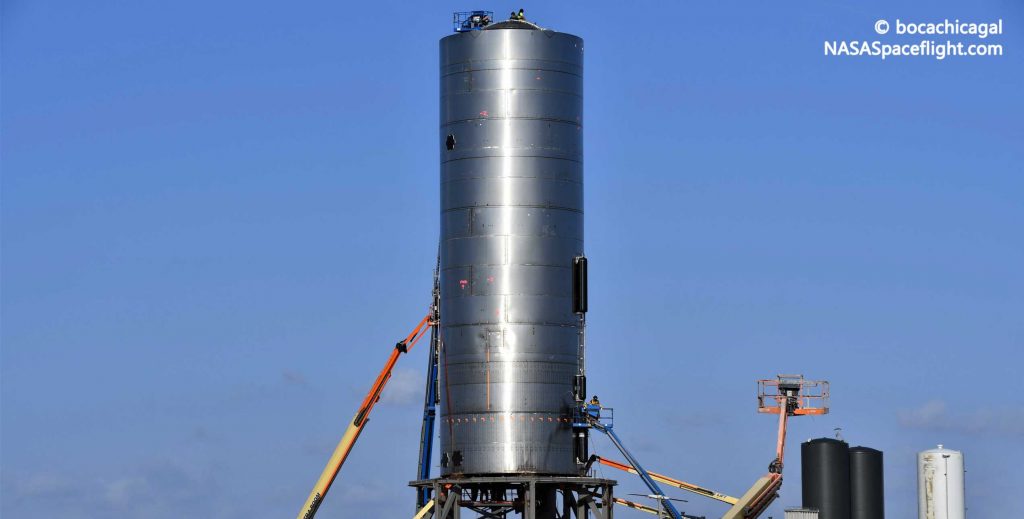
Aside from installing Raptor SN20, SpaceX teams have spent the last few days adding new COPVs (composite overwrapped pressure vessels) and plumbing to Starship SN4’s exterior – purpose largely unknown. While the new hardware is mostly a mystery, it is known that SpaceX is in the process of preparing SN4 and its new Raptor engine for a third wet dress rehearsal (WDR) and static fire test, necessary to ensure that Raptor SN20 is properly installed and functioning as expected.
Assuming that third static fire is successful, SpaceX’s will prepare Starship SN4 for its first flight, a ~150m (500 ft) hop test that will also be the first intentional flight of any full-scale Starship prototype since the program’s birth. For that hop test, SN4 will need some kind of attitude control system (ACS) thrusters to control its rotation and provide fine trajectory tuning to assist the ship’s lone Raptor engine. This is the likeliest explanation for the new hardware being installed on Starship SN4, as the ship does not currently appear to have ACS thrusters installed.
Starship Troopers
Of course, the first flight of a full-scale Starship prototype will probably be the riskiest test yet for the program and there’s a good chance that SN4 will meet its demise at some point during that flight. Enter Starship SN5.
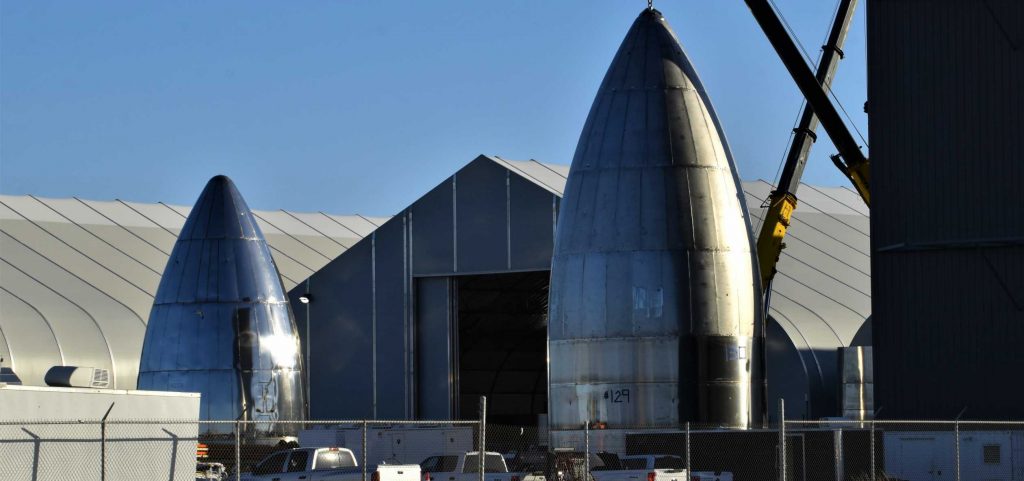
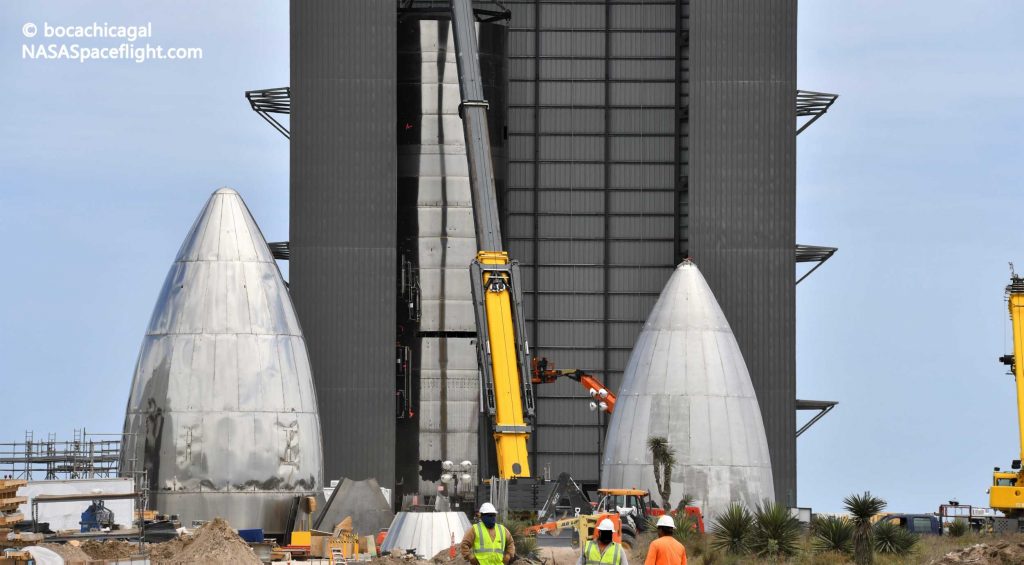
As of May 12th, Starship SN5’s final two tank sections were stacked, effectively completing the most important half of the rocket (minus one final circumferential ring weld). SN5’s final outfitting of avionics and plumbing is still pending and will take at least a few days to a week or more, but that work can and has been completed after prototypes are transferred by road to the launch pad. Currently, Starship SN4 is occupying SpaceX’s one and only pad test stand, however, meaning that it wouldn’t make much sense to immediately move SN5 to the launch pad – at least until SN4 is done testing.
SN5 will also need a nose section and, perhaps, flaps installed, meaning that the full ship is likely still at least a week or two away from being finished, but that likely wont stop SpaceX from proof testing the rocket’s tanks if or when SN4 makes space at the launch pad.
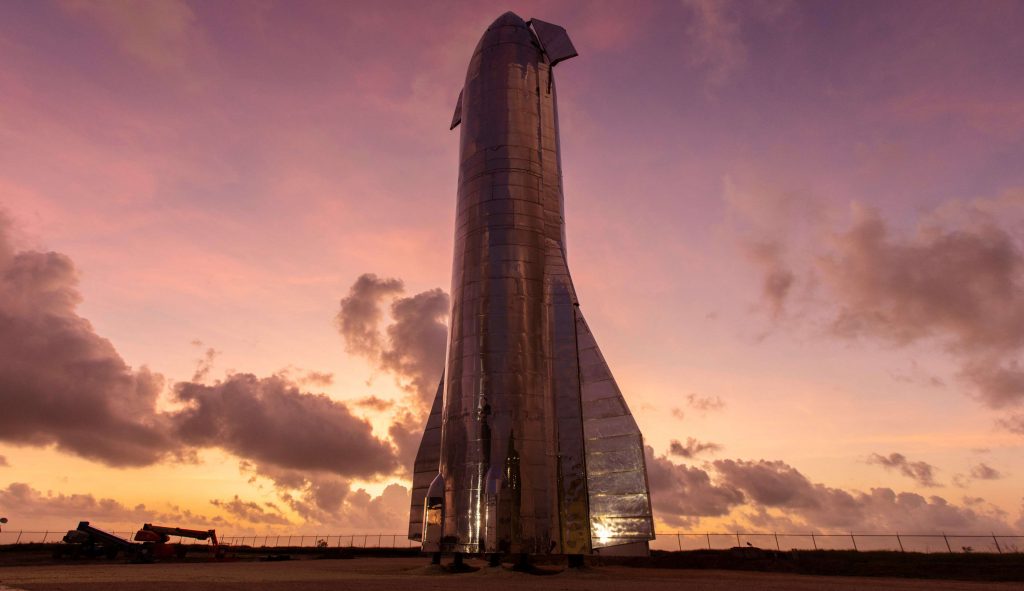
According to comments made by Elon Musk, SN5 will likely become the first Starship prototype to have three Raptor engines installed and the first to attempt a truly high-altitude flight test if Starship SN4 is met with success in the coming weeks. As absurd as it feels to say, if SN5 completes triple-Raptor testing and a 20 km (~12 mi) flight test without issue, Musk has stated that the next step would be orbital flight tests. Starship SN6’s steel rings, meanwhile, are already being formed and stacked as SN5 nears completion.

News
Tesla aims to combat common Full Self-Driving problem with new patent
Tesla writes in the patent that its autonomous and semi-autonomous vehicles are heavily reliant on camera systems to navigate and interact with their environment.

Tesla is aiming to combat a common Full Self-Driving problem with a new patent.
One issue with Tesla’s vision-based approach is that sunlight glare can become a troublesome element of everyday travel. Full Self-Driving is certainly an amazing technology, but there are still things Tesla is aiming to figure out with its development.
Unfortunately, it is extremely difficult to get around this issue, and even humans need ways to combat it when they’re driving, as we commonly use sunglasses or sun visors to give us better visibility.
Cameras obviously do not have these ways to fight sunglare, but a new patent Tesla recently had published aims to fight this through a “glare shield.”
Tesla writes in the patent that its autonomous and semi-autonomous vehicles are heavily reliant on camera systems to navigate and interact with their environment.

The ability to see surroundings is crucial for accurate performance, and glare is one element of interference that has yet to be confronted.
Tesla described the patent, which will utilize “a textured surface composed of an array of micro-cones, or cone-shaped formations, which serve to scatter incident light in various directions, thereby reducing glare and improving camera vision.”

The patent was first spotted by Not a Tesla App.
The design of the micro-cones is the first element of the puzzle to fight the excess glare. The patent says they are “optimized in size, angle, and orientation to minimize Total Hemispherical Reflectance (THR) and reflection penalty, enhancing the camera’s ability to accurately interpret visual data.”
Additionally, there is an electromechanical system for dynamic orientation adjustment, which will allow the micro-cones to move based on the angle of external light sources.
This is not the only thing Tesla is mulling to resolve issues with sunlight glare, as it has also worked on two other ways to combat the problem. One thing the company has discussed is a direct photon count.
CEO Elon Musk said during the Q2 Earnings Call:
“We use an approach which is direct photon count. When you see a processed image, so the image that goes from the sort of photon counter — the silicon photon counter — that then goes through a digital signal processor or image signal processor, that’s normally what happens. And then the image that you see looks all washed out, because if you point the camera at the sun, the post-processing of the photon counting washes things out.”
Future Hardware iterations, like Hardware 5 and Hardware 6, could also integrate better solutions for the sunglare issue, such as neutral density filters or heated lenses, aiming to solve glare more effectively.
Elon Musk
Delaware Supreme Court reinstates Elon Musk’s 2018 Tesla CEO pay package
The unanimous decision criticized the prior total rescission as “improper and inequitable,” arguing that it left Musk uncompensated for six years of transformative leadership at Tesla.

The Delaware Supreme Court has overturned a lower court ruling, reinstating Elon Musk’s 2018 compensation package originally valued at $56 billion but now worth approximately $139 billion due to Tesla’s soaring stock price.
The unanimous decision criticized the prior total rescission as “improper and inequitable,” arguing that it left Musk uncompensated for six years of transformative leadership at Tesla. Musk quickly celebrated the outcome on X, stating that he felt “vindicated.” He also shared his gratitude to TSLA shareholders.
Delaware Supreme Court makes a decision
In a 49-page ruling Friday, the Delaware Supreme Court reversed Chancellor Kathaleen McCormick’s 2024 decision that voided the 2018 package over alleged board conflicts and inadequate shareholder disclosures. The high court acknowledged varying views on liability but agreed rescission was excessive, stating it “leaves Musk uncompensated for his time and efforts over a period of six years.”
The 2018 plan granted Musk options on about 304 million shares upon hitting aggressive milestones, all of which were achieved ahead of time. Shareholders overwhelmingly approved it initially in 2018 and ratified it once again in 2024 after the Delaware lower court struck it down. The case against Musk’s 2018 pay package was filed by plaintiff Richard Tornetta, who held just nine shares when the compensation plan was approved.
A hard-fought victory
As noted in a Reuters report, Tesla’s win avoids a potential $26 billion earnings hit from replacing the award at current prices. Tesla, now Texas-incorporated, had hedged with interim plans, including a November 2025 shareholder-approved package potentially worth $878 billion tied to Robotaxi and Optimus goals and other extremely aggressive operational milestones.
The saga surrounding Elon Musk’s 2018 pay package ultimately damaged Delaware’s corporate appeal, prompting a number of high-profile firms, such as Dropbox, Roblox, Trade Desk, and Coinbase, to follow Tesla’s exodus out of the state. What added more fuel to the issue was the fact that Tornetta’s legal team, following the lower court’s 2024 decision, demanded a fee request of more than $5.1 billion worth of TSLA stock, which was equal to an hourly rate of over $200,000.
Delaware Supreme Court Elon Musk 2018 Pay Package by Simon Alvarez
News
Tesla Cybercab tests are going on overdrive with production-ready units
Tesla is ramping its real-world tests of the Cybercab, with multiple sightings of the vehicle being reported across social media this week.

Tesla is ramping its real-world tests of the Cybercab, with multiple sightings of the autonomous two-seater being reported across social media this week. Based on videos of the vehicle that have been shared online, it appears that Cybercab tests are underway across multiple states.
Recent Cybercab sightings
Reports of Cybercab tests have ramped this week, with a vehicle that looked like a production-ready prototype being spotted at Apple’s Visitor Center in California. The vehicle in this sighting was interesting as it was equipped with a steering wheel. The vehicle also featured some changes to the design of its brake lights.
The Cybercab was also filmed testing at the Fremont factory’s test track, which also seemed to involve a vehicle that looked production-ready. This also seemed to be the case for a Cybercab that was spotted in Austin, Texas, which happened to be undergoing real-world tests. Overall, these sightings suggest that Cybercab testing is fully underway, and the vehicle is really moving towards production.
Production design all but finalized?
Recently, a near-production-ready Cybercab was showcased at Tesla’s Santana Row showroom in San Jose. The vehicle was equipped with frameless windows, dual windshield wipers, powered butterfly door struts, an extended front splitter, an updated lightbar, new wheel covers, and a license plate bracket. Interior updates include redesigned dash/door panels, refined seats with center cupholders, updated carpet, and what appeared to be improved legroom.
There seems to be a pretty good chance that the Cybercab’s design has been all but finalized, at least considering Elon Musk’s comments at the 2025 Annual Shareholder Meeting. During the event, Musk confirmed that the vehicle will enter production around April 2026, and its production targets will be quite ambitious.








